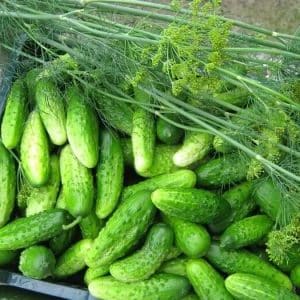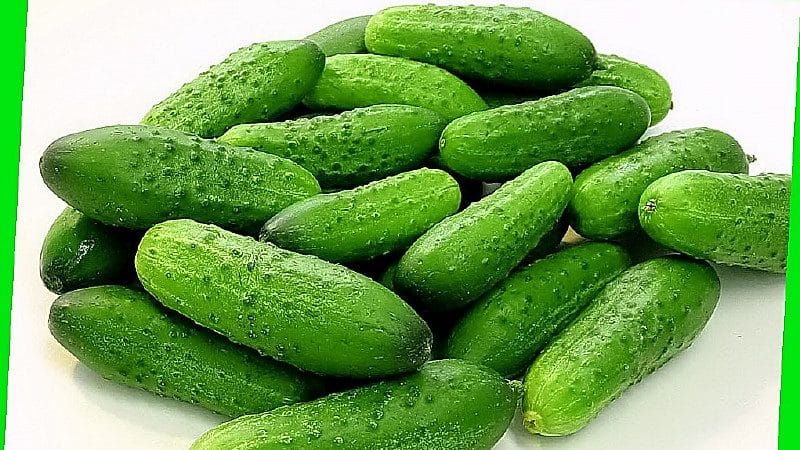Pickling cucumbers “Nezhinskie”, loved by gardeners for their ease of growing, excellent taste and aroma
Cucumber is an early-ripening, shade-tolerant, productive crop. Among all their diversity stands out variety Nezhinsky, which has gained popularity due to its pickling qualities and resistance to diseases. Gardeners get a good harvest without special skills and even in unstable weather conditions.
Let's consider the features of this variety and the basic rules of agricultural technology.
Characteristics and description of the variety
When buying unknown varieties of cucumbers, it is difficult to find out the nature of the plant and the technology for its cultivation. And with years-tested, proven Nizhyn cucumbers, it’s hard to fail.
Distinctive features:
- grown both indoors and outdoors;
- mid-season – 45-65 days from germination to fruiting;
- resistant to temperature changes and drought;
- bee-pollinated;
- rarely affected by cucumber virus;
- bears fruit until late autumn;
- one of the best varieties for pickling;
- high taste qualities.
The bush is tall, up to two meters, highly branched and powerful, fast growing. The number of shoots is up to 20, so the plant requires pinching of lashes and side branches.
The fruits are small in size: up to 12 cm in length, 4-4.5 cm in diameter, weighing 90-110 g, elongated ovoid in shape, from light to dark green in color with whitish stripes along the entire length, large tubercles and rare black spikes. They have thin skin, dense and crispy flesh.
Productivity with proper care is up to 5 kg per 1 m2.
In the photo - Nezhinsky cucumber.

Composition, properties, benefits, calorie content
Per 100 grams of vegetable there are 0.8 g of proteins, 2 g of carbohydrates, 0.7 g of fiber, 0.4 g of ash and 95.8 g of water. Sugar, starch and pectin are present in small quantities. The water accumulated in cucumber is saturated with mineral salts, which makes it healthy.
The main feature of this variety is its tasty, dense and crispy pulp. Therefore, Nezhinsky is ideal for pickling. It is also good fresh: the refreshing taste and characteristic smell of the fruit are given by organic acids and essential oils found in the skin.
The calorie content is very low - 15 kcal per 100 g of vegetable.
How to grow a variety yourself
The Nezhinsky cucumber grows in all regions of Russia, both in open and closed ground. Even novice gardeners get a good harvest, since the agricultural technology for growing the variety is simple and understandable.
Planting by seeds and seedlings
The quality of seedlings and their preparation determine the frequency of emergence and resistance to pests, diseases and low temperatures.
Important! The largest yields of cucumbers are obtained not from fresh seeds, but after three years of storage.
The seeds need to be prepared. To do this, they are first heated in the sun or on a battery for 7-10 days. Heat treatment increases seed germination, accelerates subsequent growth and increases yield. Then, for disinfection, they are placed for 30 minutes in a weak solution of potassium permanganate.
The next stage of seed preparation is soaking in clean warm water (40 degrees) until germination. A good effect is achieved by adding aloe extract to the water - a powerful biostimulator that promotes rapid seed germination.
When planting seeds directly into the ground, choose a time when the ground has warmed up sufficiently. Sow to a depth of 2.5-3 cm. Cucumbers love manure and warm soil, so a bed for them is prepared in the fall, 0.5 buckets of manure are added per 1 sq. m. m area. Then, when warm spring days arrive, the earth will quickly heat up.
More often, cucumbers of the Nezhinsky variety are grown through seedlings. Depending on the region of residence, preparation begins in March-April. First, the soil is warmed up, placed in individual cups and the seeds are sown to a depth of 1.5-2 cm. Shoots appear in 3-7 days. When the first leaves appear, the seedlings are fed with bird droppings diluted with water 1:20, or with mullein - 1:10.
When 3-5 true leaves appear, the cucumbers are taken into the greenhouse during the day or outside, if weather conditions permit. This way they are hardened for 2-3 days. Now the seedlings are ready for planting in the ground.
Attention! The rows of cucumbers are closing quickly. The Nezhinsky variety is spreading and tall, loves light and ventilation, so the distance in the row between the bushes is 1-1.2 meters. Thick planting leads to air stagnation, poor pollination of plants and the emergence of diseases.
Growing in stages and care
The plant is heat-loving, so after planting the seedlings it is necessary to monitor the air temperature in the greenhouse: maintain it at 25-28 °C in sunny weather, 20-22 °C in cloudy weather, and not lower than 16-18 °C at night. When the temperature is too high, plant pollen becomes empty, flowers are poorly pollinated and the ovaries fall off.
 Air humidity in the greenhouse is also an important condition. Watering should be frequent and only with warm water. Do not allow the soil to dry out, and also forget about ventilating the greenhouse.During the fruiting period, cucumbers consume approximately 3 liters per 1 square meter. m every other day in normal weather and 3-4 liters every day in hot weather.
Air humidity in the greenhouse is also an important condition. Watering should be frequent and only with warm water. Do not allow the soil to dry out, and also forget about ventilating the greenhouse.During the fruiting period, cucumbers consume approximately 3 liters per 1 square meter. m every other day in normal weather and 3-4 liters every day in hot weather.
To determine the degree of need for watering, take the soil at a depth of 8-10 cm and squeeze it in your hand. If the soil crumbles, immediate watering is required. If moisture remains on the hand, the soil moisture is optimal. Watering is carried out in the morning, pouring not only at the root of the plant, but also between the rows.
Now about loosening. The first surface loosening is carried out manually with a finger ripper two weeks after planting the seedlings to a depth of only 2-3 cm, so as not to damage the roots. Then once or twice a month they loosen it with a pitchfork by piercing the soil between the plants to a depth of 15-20 cm.
During the growing season, plants are hilled two or three times.
Weed control is the key to good fruiting. Any grass mercilessly takes nutrients from the ground and attracts pests. To prevent weeds from growing, it is better to mulch the soil with hay, sawdust or last year's leaves.
Features of cultivation and possible difficulties
Since the Nezhinsky cucumber variety is highly branching, it is necessary to form a bush as it grows. It is better to apply the herringbone method in reverse: leave one ovary below, two on the next lash, three even higher, and so on.
With this method, the lower part of the cucumber will be ventilated and will not get sick. Leaves and shoots should be cut with scissors and not broken out. When the bush reaches its maximum height, that is, it rests against the roof, the top is pinched or thrown over a trellis and directed downwards.
The variety requires mandatory garter. It must be done immediately after planting the seedlings. With the help of tendrils, the plant clings to the twine and is held in place.
Diseases and pests
If a white coating appears on the leaves, it means that the plant is sick with powdery mildew. You can fight it by spraying with mullein infusion: add 1 liter of mullein and 20 grams of urea to 10 liters of water.
Yellow spots on the leaves are anthracnose. To combat it, the biological product Trichodermin is used.
Like all varieties of cucumbers, Nezhinsky is affected by spider mites. To destroy the pest, use laundry soap to gently wash the leaves.
Harvesting and application

Cucumbers are harvested regularly as they ripen. It is better to do this early in the morning, while they are cold and elastic. To preserve the fruits, they are placed in a room with an air temperature of 8-10 °C. In such conditions, safety is ensured for up to two weeks.
The use of the variety is universal. The pleasant aroma, crunch and juiciness of the fresh fruit makes Nizhyn cucumbers indispensable in salads. Freshly squeezed juice acts as a remedy. But Nezhinsky showed himself best in salting and pickling. Both cold and hot processing methods are suitable for it. At the same time, the beneficial properties are preserved, and the crispy cucumber and piquant taste will delight you in winter.
Advantages and disadvantages of the variety
Advantages:
- excellent taste and versatility of use;
- fruiting before frost;
- resistance to temperature changes and drought;
- resistance to diseases;
- ease of care;
- high yield.
Flaws:
- requires the formation of a bush;
- not self-pollinating.
Reviews
The reviews speak for themselves - over the years of existence, the Nezhinsky cucumber has shown itself only from its best side.
Galina, Voronezh: “The greens ripen quite quickly and have excellent taste. I pick about two buckets of cucumbers every weekend.Enough for the whole family for salads and preparations. I sow directly into the ground in mid-April and collect the fruits before the first frost.”
Victor, Samara: “The Nezhinsky variety was grown by my parents. I really like its crunchy, sweet taste. Productivity is high. The variety is unpretentious - regular watering and fertilization in the fall is enough. I recommend to all!"
Anna, Krymsk: “I planted Nezhinsky for the first time about seven years ago. Since then, I have been growing the variety constantly and reaping large harvests. Never let me down."
Conclusion
Over several decades, the Nezhinsky variety has established itself as consistently productive, unpretentious in care, with long-term fruiting and excellent taste characteristics. By following the basic rules of agricultural technology, even novice gardeners get a rich harvest of Nizhyn cucumbers.
The versatility of the variety is time-tested: the fruits are good both fresh and canned.